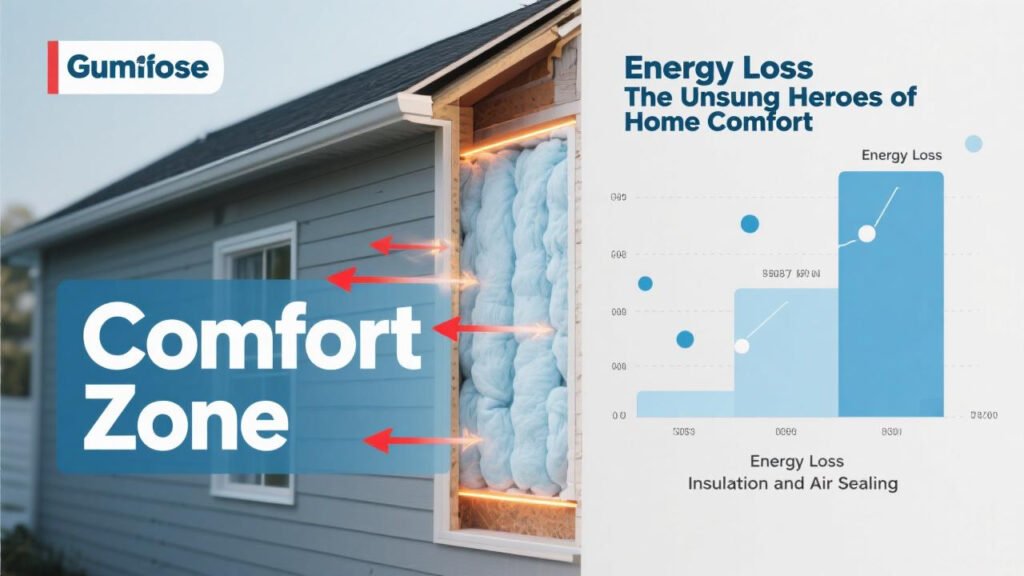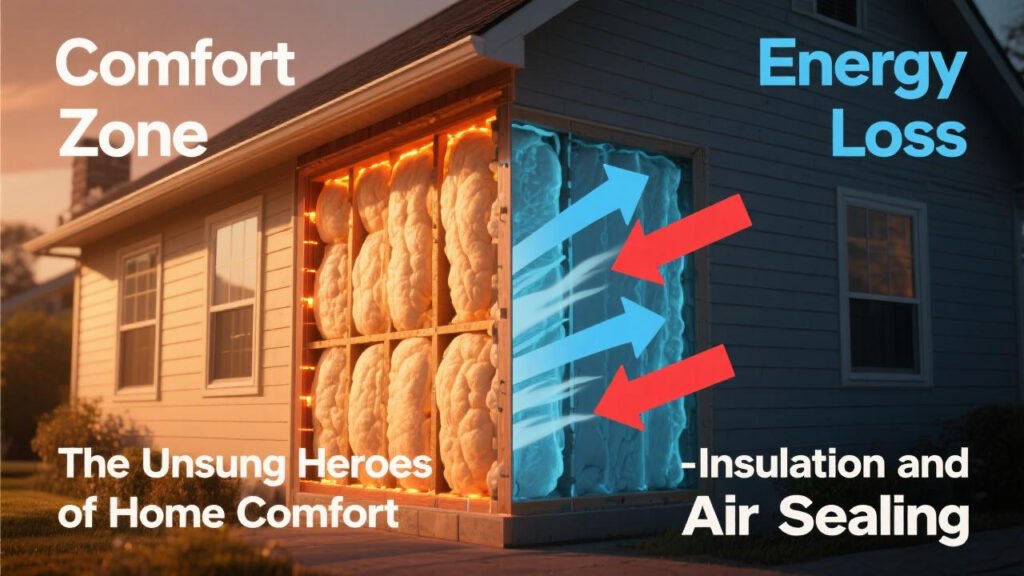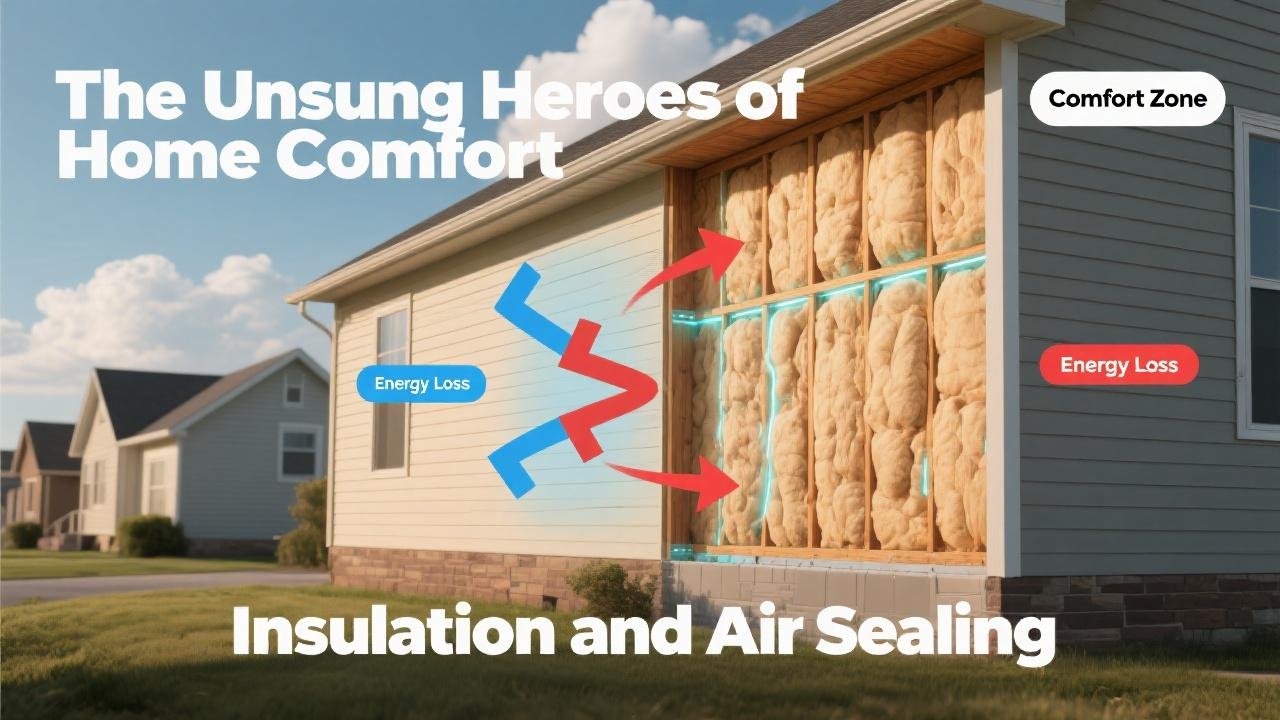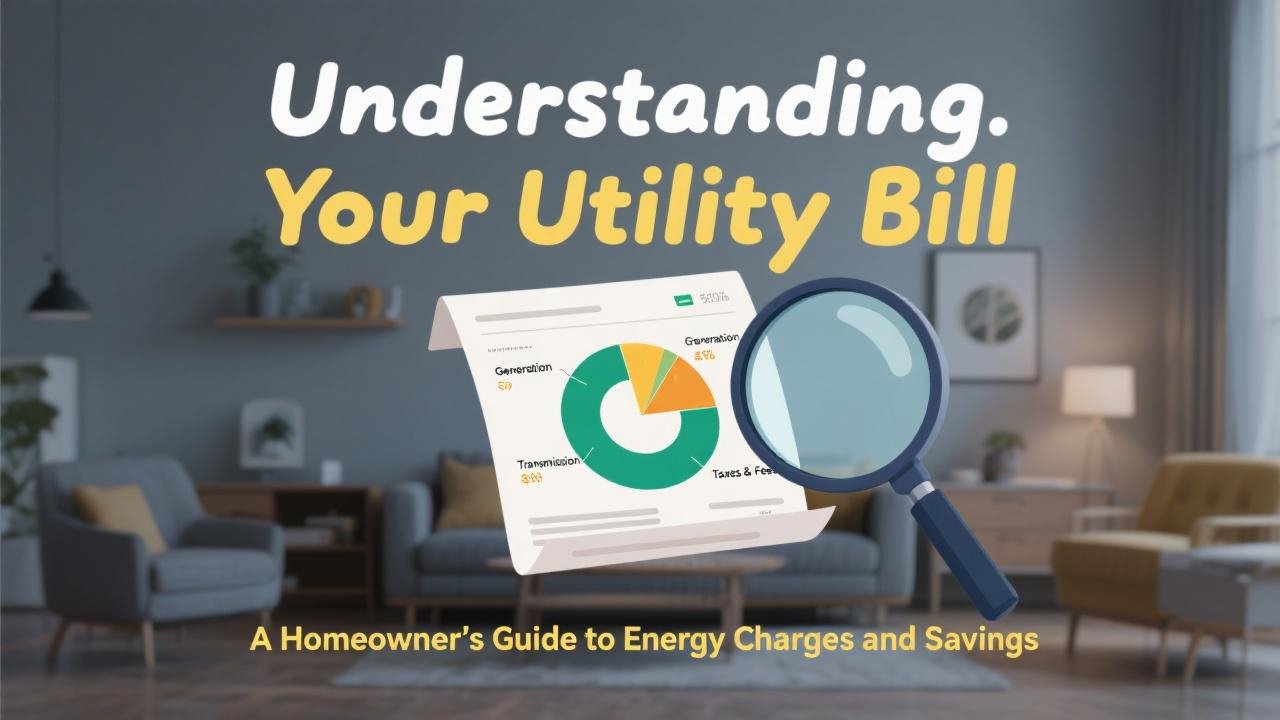Your Home’s First Line of Defense Against Energy Waste
When thinking about home energy efficiency in 2025, high-tech solutions like smart thermostats or heat pumps often come to mind. However, two of the most fundamental and cost-effective ways to make your home more comfortable and reduce your energy bills are often unseen: proper insulation and comprehensive air sealing. These unsung heroes work together to create a tighter building envelope, keeping conditioned air in and unconditioned air out, significantly reducing the workload on your heating and cooling systems. This guide will explore the importance of insulation and air sealing, common problem areas, and how addressing them can lead to substantial energy savings.
Improving your home’s insulation and air sealing is often a top recommendation from home energy audits, like those guided by ENERGY STAR principles, as they provide a high return on investment.
Why Insulation and Air Sealing are Crucial
- Insulation: Acts as a thermal barrier, slowing the movement of heat. In winter, it keeps the heat generated by your HVAC system inside your home. In summer, it prevents the sun’s heat from entering and keeps cooled air from escaping. Proper insulation helps maintain consistent indoor temperatures.
- Air Sealing: Addresses the cracks, gaps, and openings in your home’s “envelope” (walls, foundation, roof, windows, doors) that allow uncontrolled air leakage. This leakage, often felt as drafts, can account for a significant portion of your home’s heating and cooling costs.
Benefits of a Well-Insulated and Air-Sealed Home:
* Reduced Energy Bills: By minimizing heat loss in winter and heat gain in summer, your HVAC system doesn’t have to work as hard or as often, leading to lower energy consumption. Savings can be significant – ENERGY STAR estimates that homeowners can save an average of 15% on heating and cooling costs (or an average of 11% on total energy costs) by air sealing their homes and adding insulation in attics, floors over crawl spaces, and basements.
* Improved Comfort: Eliminates drafts and cold spots in winter, and helps keep your home cooler and less humid in summer. Temperatures will be more consistent throughout your house.
* Enhanced Indoor Air Quality: Air sealing can prevent pollutants, dust, and allergens from entering your home through cracks and gaps. (Note: Proper mechanical ventilation becomes more important in very airtight homes).
* Increased HVAC System Lifespan: Reducing the workload on your heating and cooling equipment can help it last longer and require fewer repairs.
* Moisture Control: Proper insulation and air sealing, combined with appropriate vapor barriers, can help prevent moisture problems that can lead to mold and structural damage.

Common Problem Areas for Air Leaks and Insufficient Insulation:
A professional home energy audit using tools like a blower door test and infrared camera can precisely locate these issues, but common culprits include :
- Attic:
- Attic Hatch/Access Door: Often poorly sealed and insulated.
- Recessed Lighting Fixtures: Can be major sources of air leakage into the attic.
- Plumbing Vents, Wiring Holes, Chimney Chases: Gaps around these penetrations.
- Insufficient or Uneven Insulation: Many older homes have inadequate attic insulation.
- Basement and Crawl Space:
- Rim Joists (where the foundation meets the wooden frame of the house): A notorious spot for air leaks and often uninsulated.
- Sill Plates: Gaps between the foundation and the sill plate.
- Crawl Space Vents (if unconditioned crawl space):
- Windows and Doors:
- Gaps around frames.
- Worn or missing weatherstripping.
- Electrical Outlets and Switches on Exterior Walls:
- Plumbing and Utility Penetrations through Exterior Walls:
- Fireplaces: Dampers that don’t seal properly.
Types of Insulation Materials Commonly Used in 2025:
- Fiberglass (Batts and Blown-in): Made from fine glass fibers, common and relatively inexpensive. Available in pre-cut batts or loose-fill for blowing into attics or wall cavities.
- Cellulose (Blown-in): Made from recycled paper products, treated for fire and insect resistance. Good for filling existing wall cavities and attics.
- Spray Foam (Open-cell and Closed-cell): A polyurethane foam that is sprayed into place and expands to fill gaps and cavities. Excellent for air sealing and provides a high R-value (insulating power) per inch. Closed-cell is more dense, provides a vapor barrier, and has a higher R-value than open-cell.
- Rigid Foam Boards (EPS, XPS, Polyiso): Polystyrene (Expanded or Extruded) or Polyisocyanurate boards. Good for foundation walls, basement walls, and sometimes exterior sheathing. Polyiso generally has the highest R-value per inch.
- Mineral Wool (Rock Wool or Slag Wool): Made from rock or industrial slag. Fire-resistant and good sound-dampening qualities.
The “R-value” of insulation indicates its resistance to heat flow – the higher the R-value, the better its insulating properties. ENERGY STAR provides recommended home insulation R-values based on your climate zone.

DIY Air Sealing and Insulation Tips:
While larger insulation jobs are often best left to professionals, here are some DIY tasks:
* Caulk and Weatherstrip: Seal gaps around windows, doors, and baseboards. (Covered in previous DIY article).
* Seal Electrical Outlets and Switch Plates: Use foam gaskets behind the cover plates on exterior walls.
* Seal Around Plumbing and Wiring Penetrations: Use caulk or expanding foam (use low-expansion foam around windows and doors) to seal gaps where pipes and wires enter your home or pass through floors into attics/basements.
* Insulate Attic Hatch: Attach rigid foam board or fiberglass insulation to the attic side and weatherstrip the edges.
* Check and Top Up Attic Insulation (if comfortable and safe): If you can safely access your attic and the insulation is below the joists, you might consider adding more loose-fill insulation. Wear appropriate protective gear (mask, gloves, goggles).
When to Call a Professional:
- Comprehensive Air Sealing: Professionals can use a blower door test to find all hidden leaks and effectively seal them.
- Major Insulation Projects: Installing insulation in walls, large attic areas, or crawl spaces, especially if it involves blown-in insulation or spray foam, is typically best done by experienced contractors. They have the right equipment and knowledge of safety precautions.
- Addressing Ventilation Needs: As you tighten your home, proper mechanical ventilation (like an Energy Recovery Ventilator – ERV, or Heat Recovery Ventilator – HRV) might be necessary to ensure good indoor air quality. A professional can assess this.
- Combustion Safety: If sealing up areas around combustion appliances (furnace, water heater), ensure they are still venting properly.
Incentives for Insulation and Air Sealing in 2025:
The Energy Efficient Home Improvement Credit (federal tax credit) allows homeowners to claim 30% of the cost of qualified insulation and air sealing materials or systems, up to certain annual limits (e.g., these items don’t have a specific credit limit beyond the overall $1,200 annual limit for such improvements, excluding heat pumps etc.). Many states and utilities also offer rebates.
Building a More Resilient and Efficient Home Envelope
Proper insulation and air sealing are foundational to home energy efficiency in 2025. By creating a robust thermal barrier and minimizing uncontrolled air leakage, you can significantly reduce your heating and cooling costs, improve indoor comfort, and lessen your environmental impact. Whether you tackle some DIY projects or hire professionals for a comprehensive upgrade, investing in your home’s envelope is a smart decision that pays dividends for years to come. Start by assessing your home, perhaps with guidance from ENERGY STAR resources or a professional energy audit, to identify the most impactful areas for improvement.



